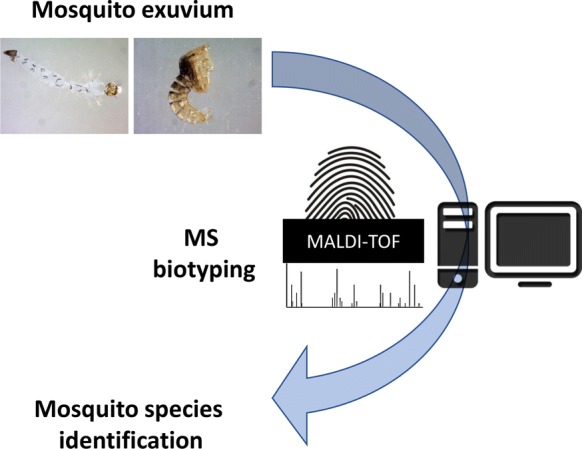- Record: found
- Abstract: found
- Article: found
Identification of Aedes mosquitoes by MALDI-TOF MS biotyping using protein signatures from larval and pupal exuviae

Read this article at
Abstract
Background
Matrix-assisted laser desorption/ionization time-of-flight mass spectrometry (MALDI-TOF MS) biotyping is an innovative strategy, applied successfully for the identification of numerous arthropod families including mosquitoes. The effective mosquito identification using this emerging tool was demonstrated possible at different steps of their life-cycle, including eggs, immature and adult stages. Unfortunately, for species identification by MS, the euthanasia of the mosquito specimen is required.
Methods
To avoid mosquito euthanasia, the present study assessed whether aedine mosquitoes could be identified by MALDI-TOF MS biotyping, using their respective exuviae. In this way, exuviae from the fourth-instar and pupal stages of Aedes albopictus and Aedes aegypti were submitted to MALDI-TOF MS analysis.
Results
Reproducible and specific MS spectra according to aedine species and stage of exuviae were observed which were objectified by cluster analyses, composite correlation index (CCI) tool and principal components analysis (PCA). The query of our reference MS spectra database (DB) upgraded with MS spectra of exuviae from fourth-instar larvae and pupae of both Aedes species revealed that 100% of the samples were correctly classified at the species and stage levels. Among them, 93.8% (135/144) of the MS profiles reached the threshold log score value (LSV > 1.8) for reliable identification.
Conclusions
The extension of reference MS spectra DB to exuviae from fourth-instar and pupal stages made now possible the identification of mosquitoes throughout their life-cycle at aquatic and aerial stages. The exuviae presenting the advantage to avoid specimen euthanasia, allowing to perform complementary analysis on alive mosquitoes.

Related collections
Most cited references36
- Record: found
- Abstract: found
- Article: not found
Effects of Temperature and Trophic State on Degradation of Environmental DNA in Lake Water.

- Record: found
- Abstract: found
- Article: found
Integrated Aedes management for the control of Aedes -borne diseases
- Record: found
- Abstract: found
- Article: not found